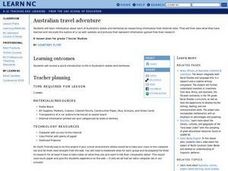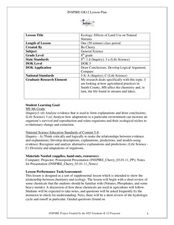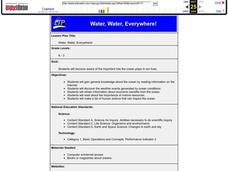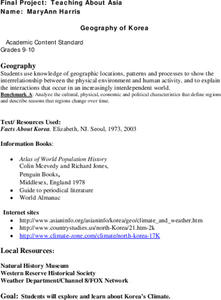Curated OER
Australian Travel Adventure
Seventh graders are introduced to the states and territories within Australia. Using the internet, they bookmark sites and take notes on what they want to share with their classmates. They also complete a map study on the country to...
Curated OER
Water Stories
Students interpret historical accounts, stories and customs to draw conclusions about the people who populated New Mexico and their relationship to water. They describe the human and natural characteristics of places in New Mexico.
Curated OER
Introduction to Biomes
Eighth graders identify the different kinds of biomes. In this life science instructional activity, 8th graders explain their importance in an ecosystem. They take a BrainPop quiz at the end of the instructional activity..
Curated OER
Got Biodiversity?
Students examine the concept of biodiversity. Using the internet, they complete small activities in which they work together. Using the information they collected, they create a class book, make murals and write in their journals.
Curated OER
Polar Day: Living in the Canadian North
Students study the Canadian North. In this Canadian North lesson, students study the physical characteristics and the lifestyles of people in that region. Students complete map making and creative activities that help them learn about...
Curated OER
Ecology: Effects of Land Use on Natural Streams
Eighth graders examine how humans affect various ecosystems. In this ecology instructional activity, 8th graders discuss different ways that contaminants enter the stream. They explain the consequences of eutrophication in lakes.
Curated OER
Observation and Discovery
Students explore the basic skills guiding sound scientific invvestigation and methodology. They are introduced to a powerful scientific tool-the microscope. Students review the parts of the microscope. They discuss the inventor of the...
Curated OER
Ask an Expert-Grade 5-8
Students conduct oral histories about water in their community. They interview community members, create a class oral history journal, and record their findings on a school website, in the school or public library, or in another...
Curated OER
Germinating Seeds on Gelatin
Students germinate seeds in unflavored gelatin to which liquid house plant food has been added. Students observe and record plant growth in this medium with a variety of variables in a number of experiments.
Curated OER
Water, Water, Everywhere!
Students become aware of the important role the ocean plays in our lives. Students will gain general knowledge about the ocean by reading information on the Internet. They discover the weather events generated by ocean conditions.
Curated OER
Creating a Landmark Calendar-An Enterprise for Your School
Students scrutinize the steps necessary to produce a school calendar featuring local architectural sites and landmarks.
Curated OER
Diversity and Adaptations of Organisms
Eighth graders discover the difference between extinct and endangered animals and discuss the reasons why this has occured. They identify threatened and endangered animals living in their local area as well.
Curated OER
Water Mitigation
High schoolers identify the major health effects of arsenic contamination. They explain how arsenic gets into groundwater in Bangladesh. Students list ways to prevent arsenic from getting into drinking water. They explain why access to...
Curated OER
Introduction to Ecology
Eighth graders identify the living and nonliving components of an ecosystem. In this ecology lesson, 8th graders explain the role each organism plays. They participate in class discussion and answer a quiz at the end of the lesson.
Curated OER
the Wonder of Wetlands
Students explore the importance of the wetland ecosystem, its properties and functions, as well as, the many birds, animals, and plant life found there.
Curated OER
This Place is Going to the Dogs
Students study different breeds of dogs. They watch a video, "Extraordinary Dogs", about special dogs and how they are categorized according to their adaptations. Then they create a digital video that demonstrates the qualities of dogs...
Curated OER
California Primary 2000
Students explore the open primary system and the candidates that appeared on the ballot in California's Presidential Primary in 2000. A variety of issues and sites are explored and form the focus of this instructional activity.
Curated OER
Geography of Korea
Students are introduced to the geography of Korea. Using the internet, they identify the weather and climate in the country and create a week weather chart for Korea's four seasons. They complete an interview with a local weatherman...
Curated OER
Behind the Ad: The Process of Producing a Political Commerical
Students examine how advertisements are produced for political campaigns. In groups, they view various examples of different advertisements and create their own ad by completing the steps listed in the lesson plan. They share their ad...
Curated OER
Creatures of the Ocean
Second graders examine the characteristics of a specific ocean creature. In pairs, 2nd graders create a graphic organizer to list categories and supporting details of the ocean creature. Students review data and use it to write a report...
Curated OER
Artists as Explorers
Students brainstorm a list of famous explorers from the past. In groups, they complete a worksheet analyzing the art of Karl Bodmer and how one could view him as an explorer as well. They answer discussion questions to end the...
Curated OER
Non-Objective Constructed Sculpture
Students begin their examination of non-objective artwork. Individually, they participate in activities in which they take designs within other images and use them for their focus in their art. They create a sculpture with the new...
Curated OER
Past, Present, and Future
Students explore school history by documenting daily life. In this time capsule lesson, students discuss the impact a fire had on their school during the previous year and identify ways to preserve information about their school by...
Curated OER
You say Avocado, I say Avogadro
Students convert mole to mass to particles and vice versa. In this chemistry lesson, students discuss the importance of Avogadro's number. They apply what they have learned in a team competition.

























